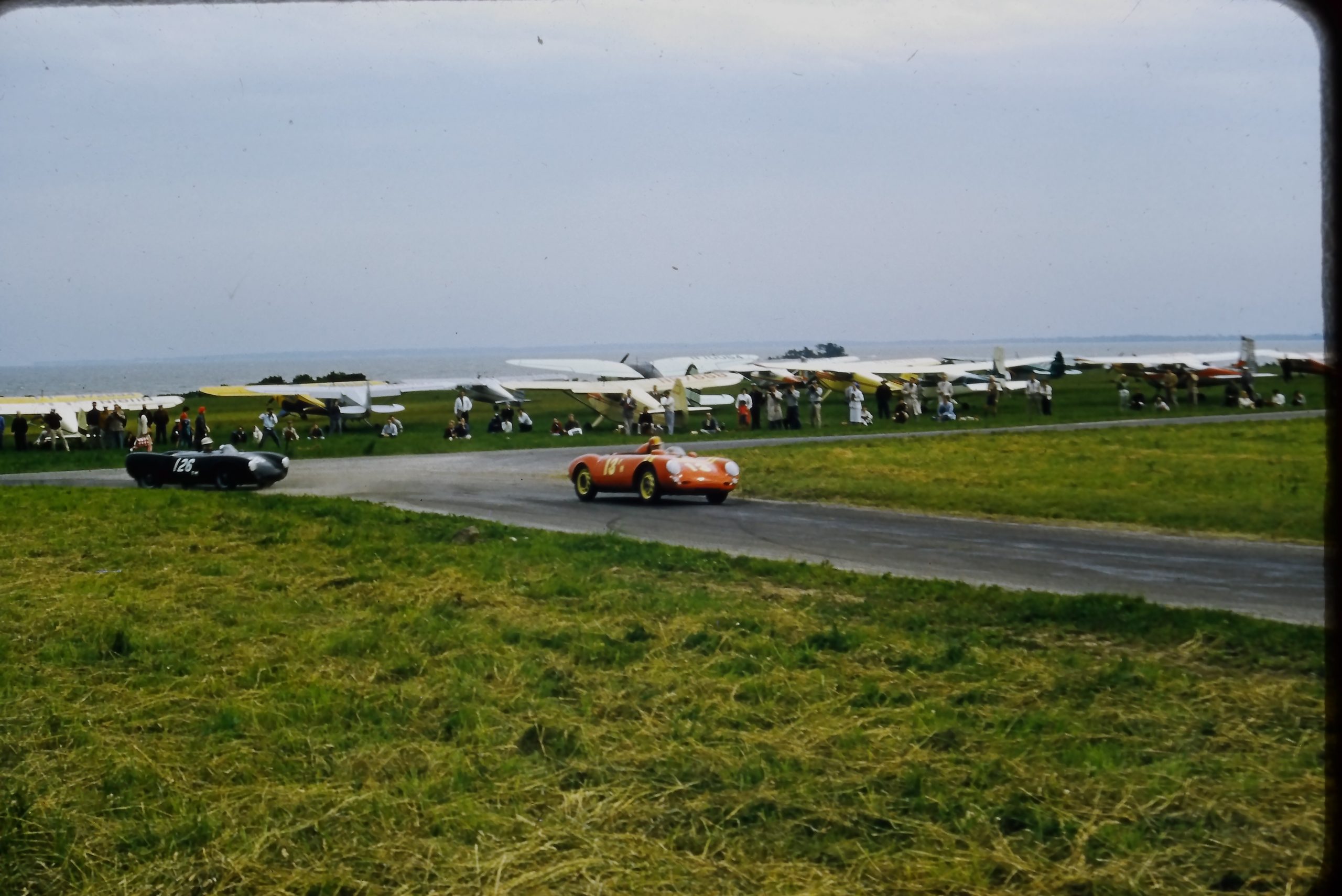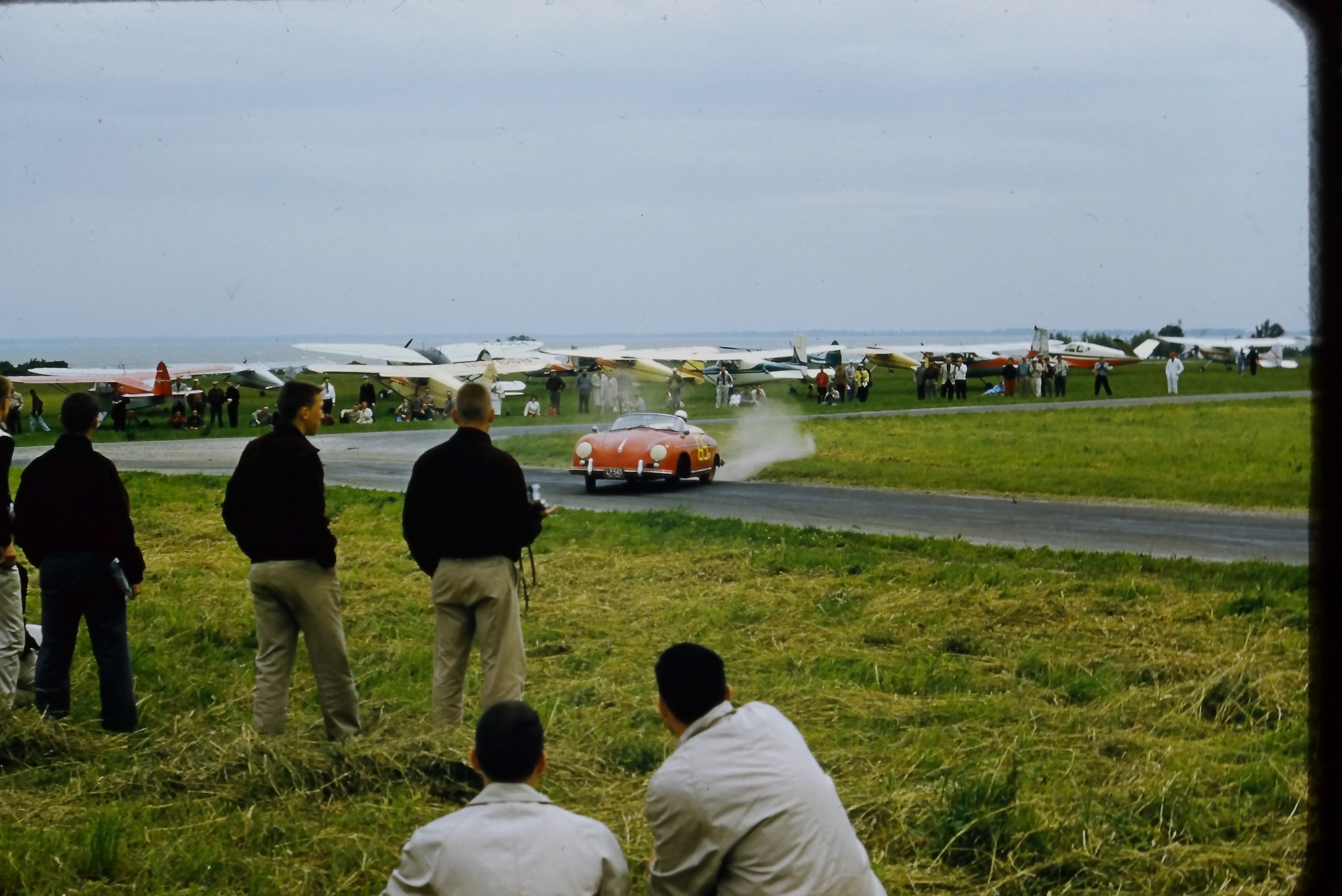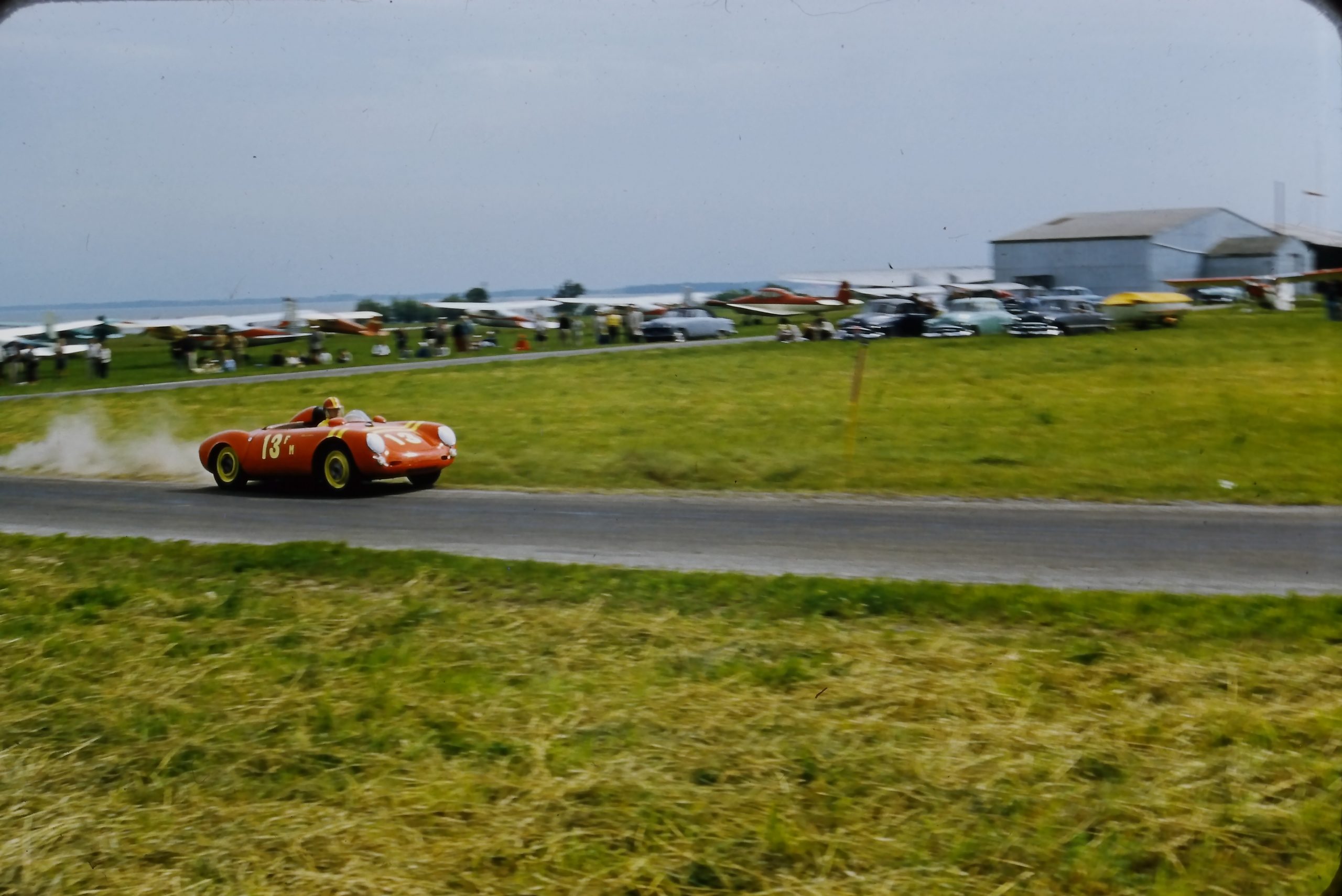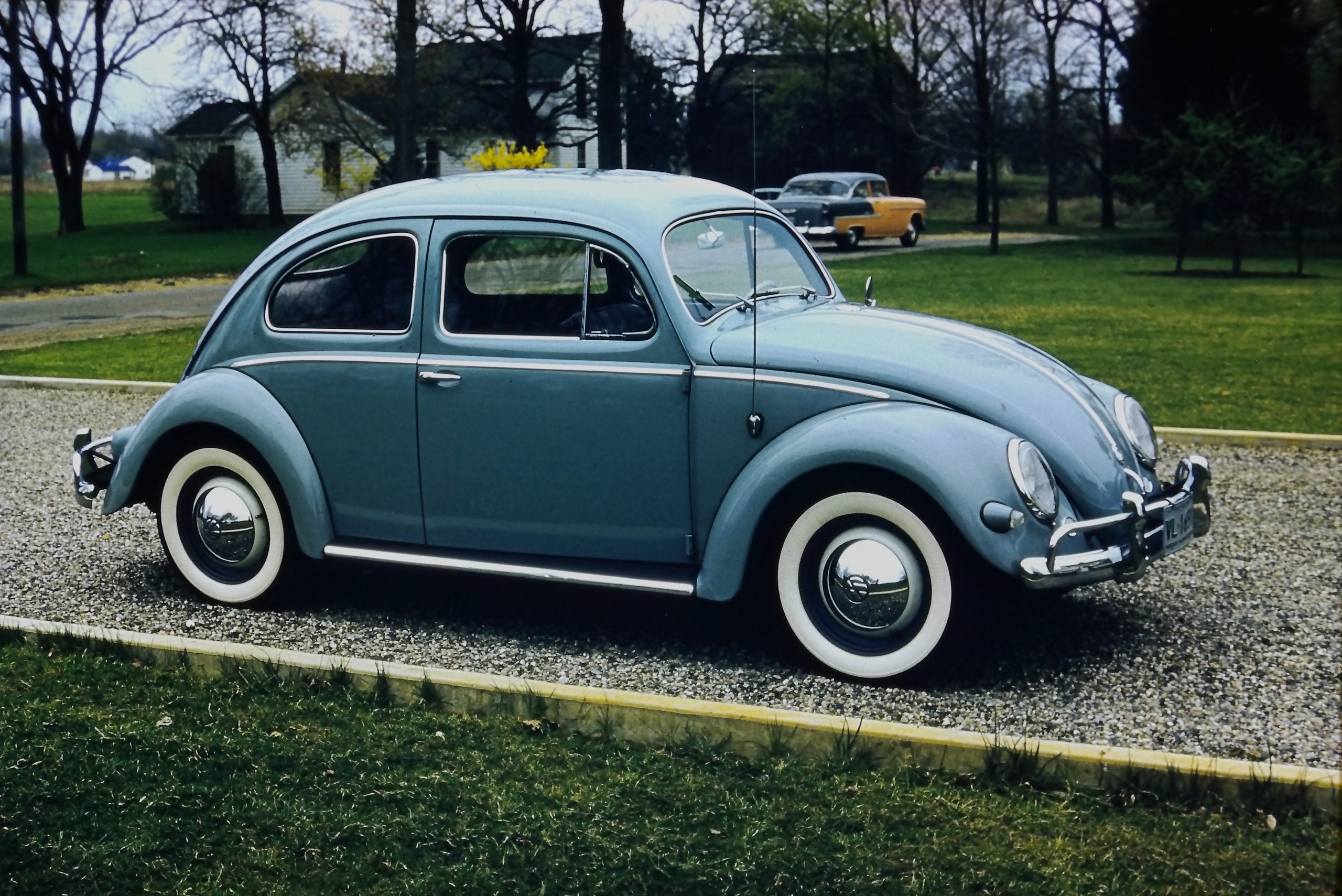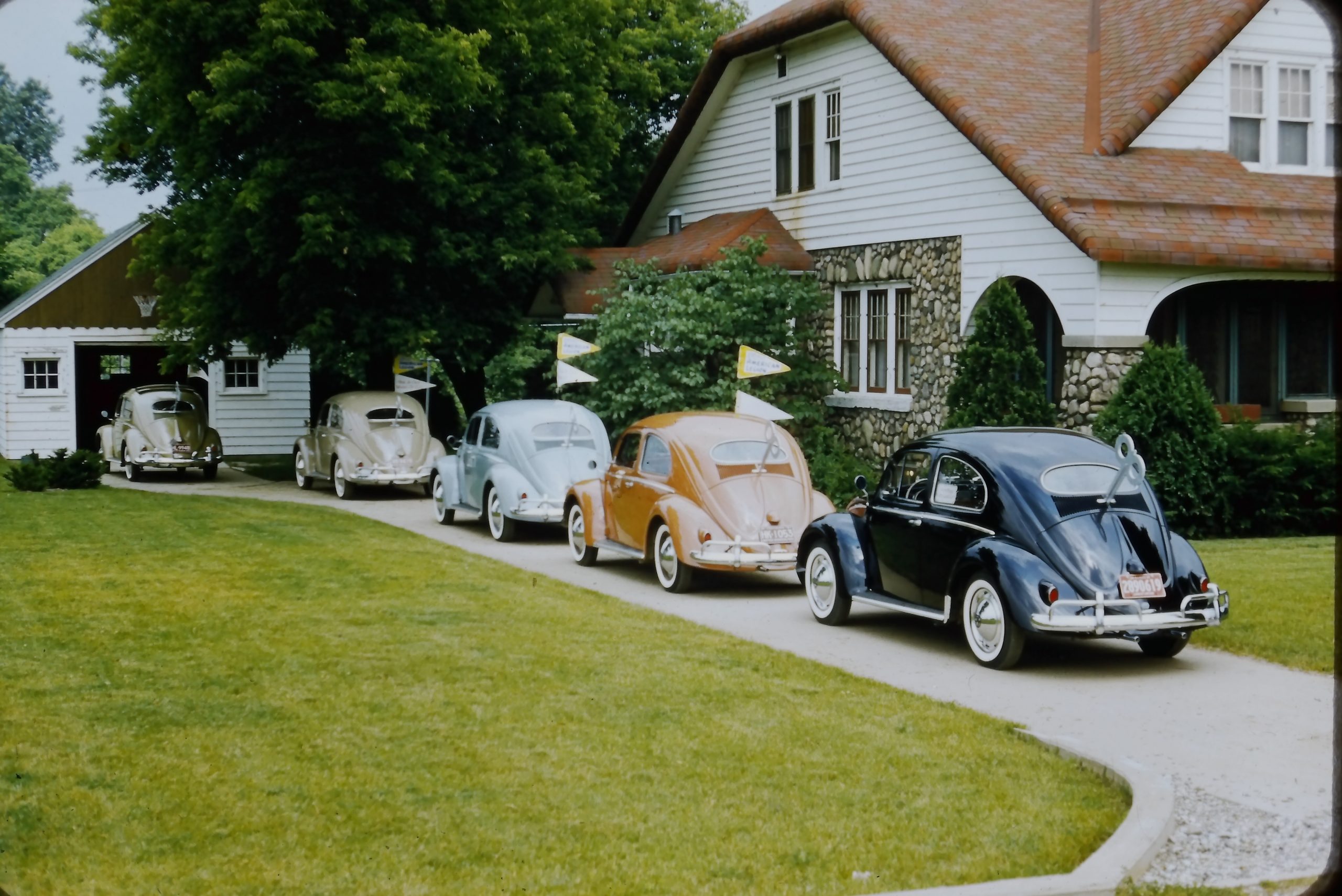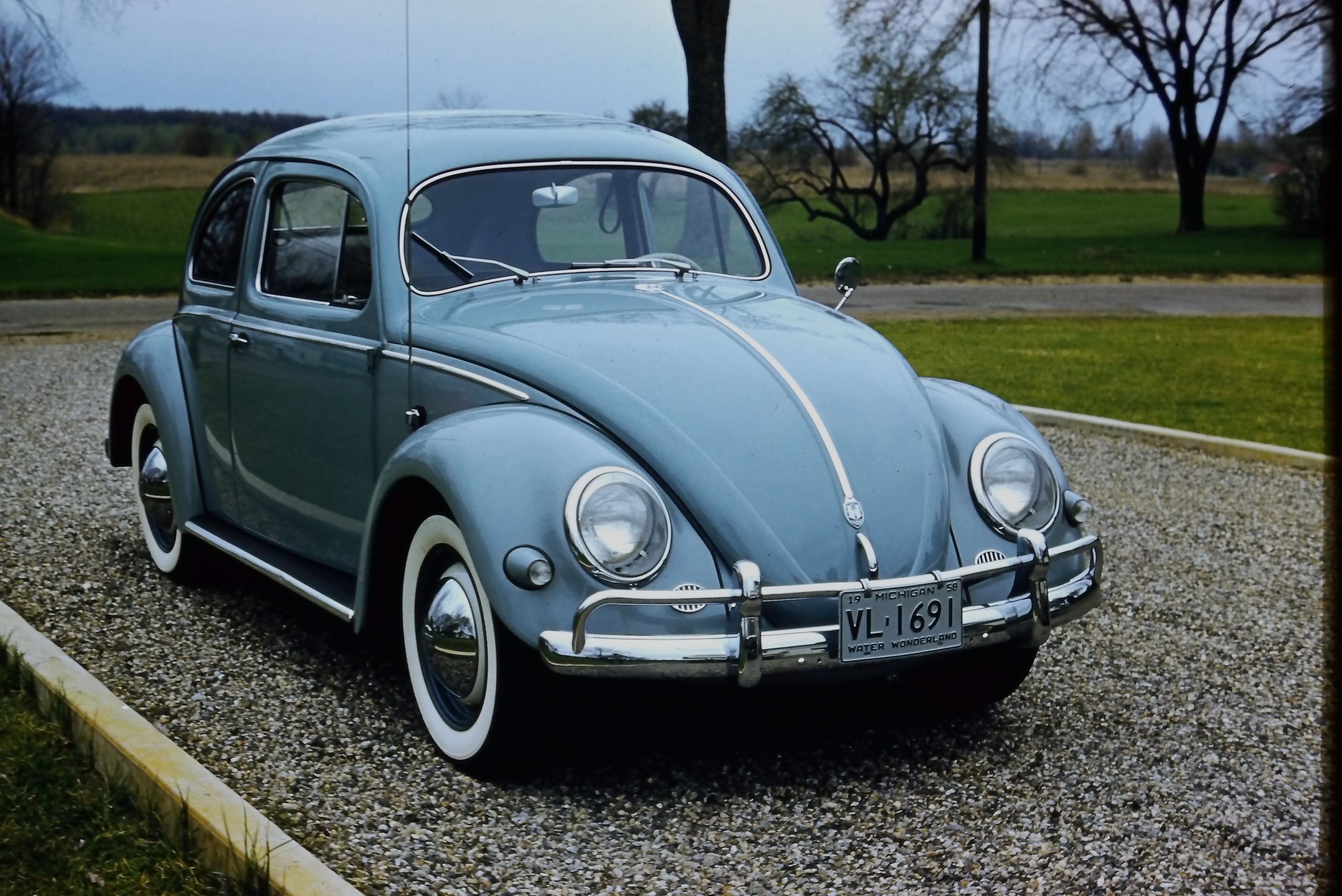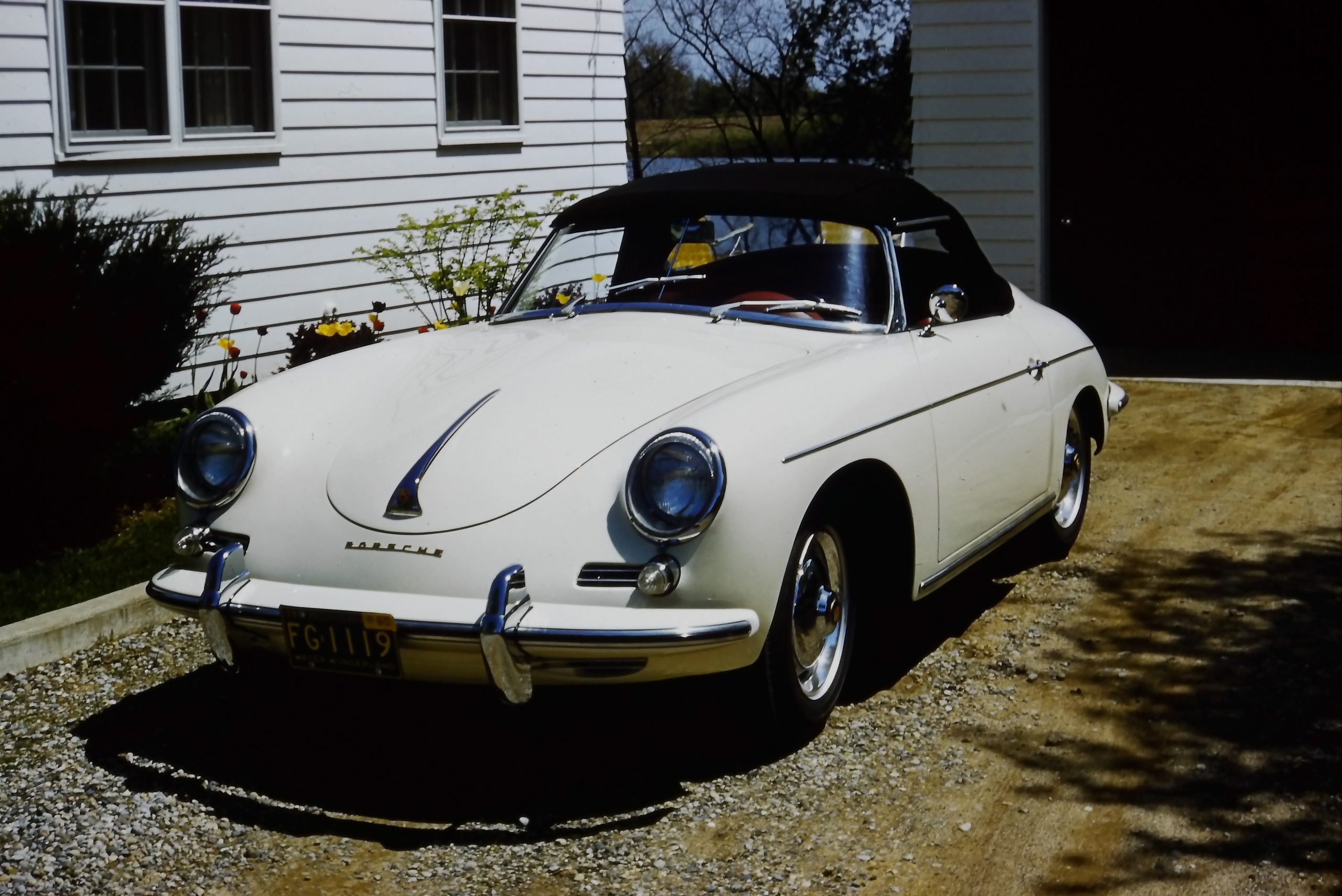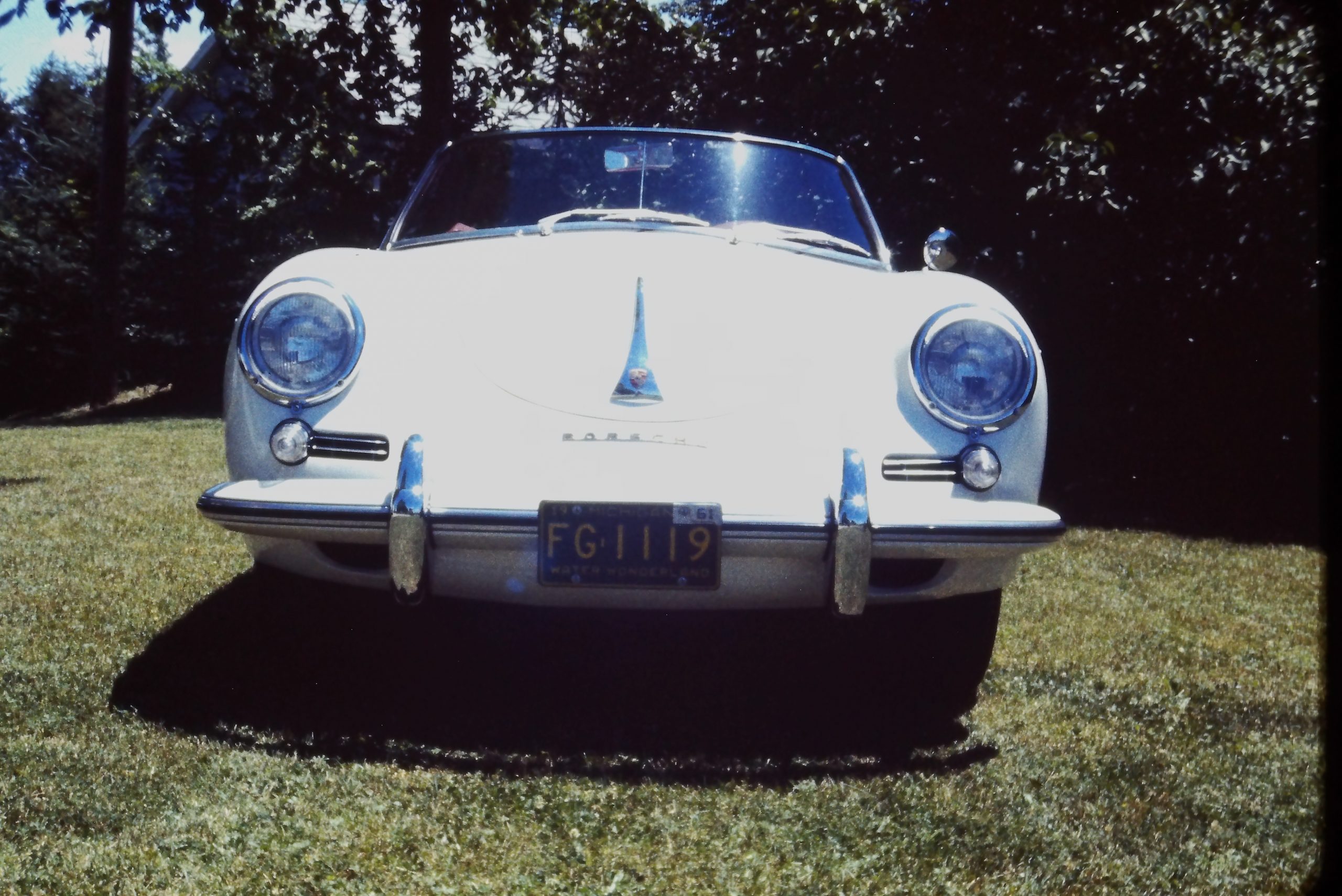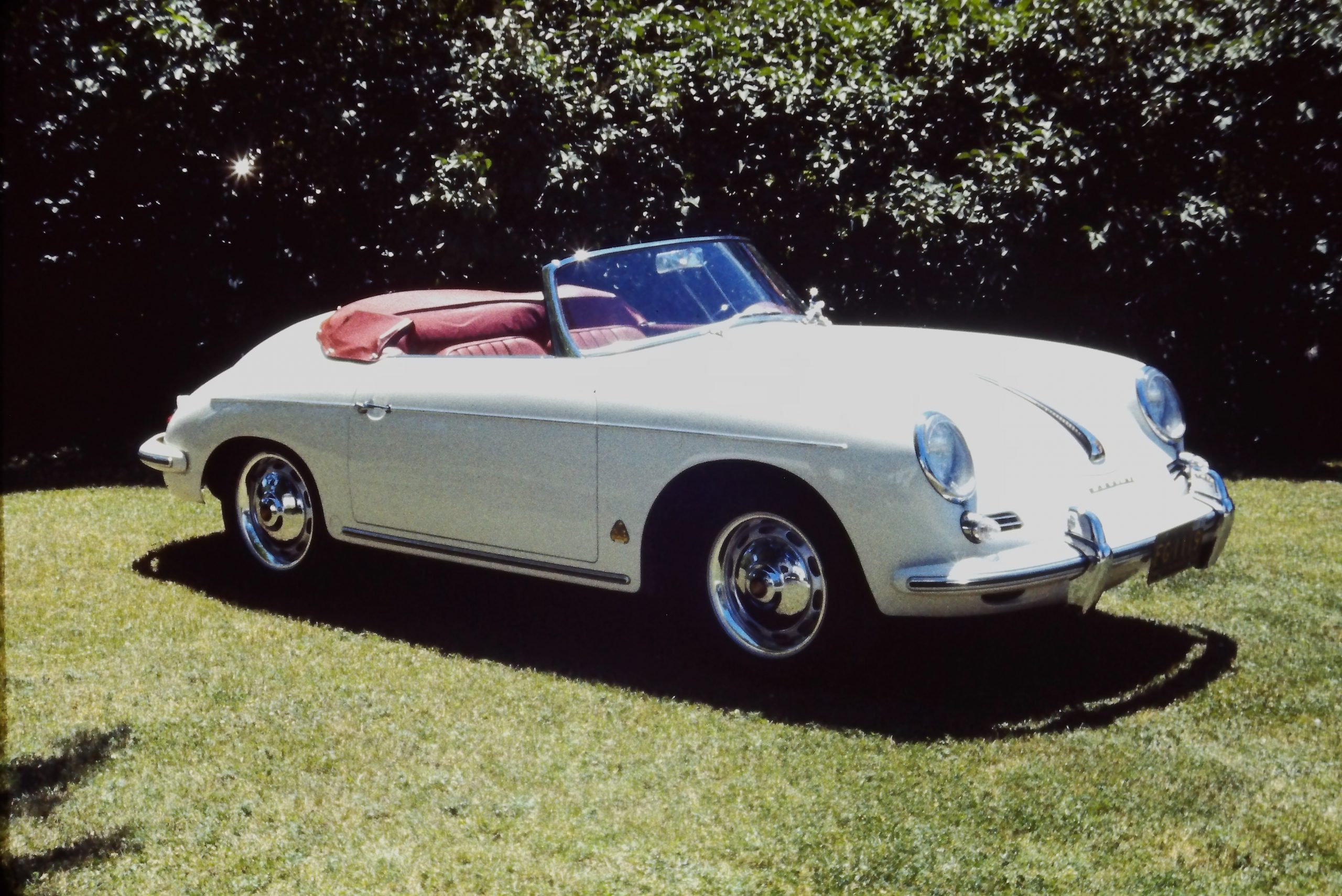The Open Road Chronicle
A Photo History Story
The vintage photographs on this page were taken by my dad, Howard J. Cole, long before the age of ubiquitous images. The related short stories are a snapshot of our family history.
Chapter 1
Put-In-Bay Road Race
.
It wasn’t the likeliest spot for a speed mecca, just a little village on a little island in Lake Erie, but there was something special happening in Put-in-Bay, and the racers knew it. They competed for silver cups in an age when there were no sponsors and no prize money. The drivers were car salesmen, stock brokers, engineers, printers, etc. Often the cars they raced were those they drove as daily transportation. For a few memorable years, they drove their MGs, Austin-Healeys, Triumphs, Alfas and Porsches to Ohio’s northern shore, rolled onto a car ferry bound for South Bass Island and rolled off onto one of the last real American road courses.
In 1957, road racing in America was in its golden age. However, open street courses like Put-In-Bay were giving way to closed courses like Watkins Glen, Bridgehampton, and almost all the West Coast tracks. “All the honest-to-God road races were disappearing”, as Bill Jackson, one of the drivers in 1957 at Put-In-Bay put it. The wide open, everyday streets of Put-in-Bay were certainly part of its grassroots appeal. But it wasn’t the racing so much as the cars that enthralled my dad and taking photos of them ushered in a decades long hobby, providing a treasure trove of family history.
I suspect that my dad’s enthusiasm for automobiles started in high school. He and my mom were members of the Brighton High School class of 1947. As classmate Charles Reicks recalls, “Howard always somehow managed to get gas in those days of gas, sugar and coffee rationing. On cold snowy winter evenings, we would tie a rope on the bumper of Howard’s 1934 Ford Coupe and ride a toboggan around town – hanging on for dear life.”
The Put-in-Bay Road Races ran from 1952 to 1959 and then one final time on an abbreviated course in 1963. No big purse to contest there—it was racing for racing’s sake. Restricting road cars to 2.0 liters and under added a safety factor that probably made the thing possible in the first place, even as it kept big-name drivers away. But the participants had to have known it couldn’t last forever; the cars were getting too fast.
Open course road racing safety was light-years away from today. As Bill Jackson noted, “You’d drive them to a track, take the windshield off … we didn’t even have roll bars.” The Put-In-Bay village’s main street, Delaware Avenue, hosted the course’s starting line, kicking off 3.1 miles of harrowing corners, questionable road surfaces and a 5,825-foot whopper of a straight that made drivers wring out their small-displacement machines for all they were worth. All on public roads. The safety barriers? Hay bales.
The feature race on June 8th, 1957 included a couple of Porsche Spyders along with the Lester MG of Ted Jayne and the fast MGTC of Detroit’s Bill Bradley plus several production sports cars: ACs, Morgans, Triumphs and Siata’s powered by Porsche and Offendhaurser engines. The winner was Tom Payne’s Spyder followed closely by Ted Jayne in the Lester MG, and my dad was there to admire the cars, especially the Porsches, and photograph the action.
The last year of the Cleveland Sport Car Club (CSCC) sanctioned Put-In-Bay Road Races was 1959. “In 1959, you had Manny Holder in a Porsche 550 Spyder going 140 miles an hour down Cooper Straight into town,” says Manley Ford, Put-in-Bay Road Races Reunion event co-director. “Imagine the roads being just chip-and-peel, some not even that, and much rougher. Down on Meechen Road, there were ruts from a tree that would just rip the bottom out of a car if it was too low. The long straight was the longest in sports-car racing, around a mile long. Can you imagine driving a Bug-Eyed Sprite flat-out for a mile?”
After CSCC decided to end the races in 1959, there were many who wanted them to continue and so the 1963 race, organized by a group from the Waterford Hills Road Racing Track, Clarkston, Michigan, came into being. That year, there was a potentially serious accident when a spectator ran across the course in front of an Elva Mk IV, which crashed into a telephone pole to avoid him. As Porsche guru Vic Skirmants notes, the car hit on the “passenger” side, shearing off the carburetors and totaling the car. According to race official Jack Holth, “They couldn’t even find the driver. Until he was located sitting at the base of a nearby tree, having a cigarette. That was the end of wheel-to-wheel racing at Put-in-Bay.” However, it was just the beginning of closed-course road racing in Michigan, north of Detroit at Waterford Hills, and my parents’ open-road adventures.
References:
- Autoweek. (2017, November 24). Then And Now: The Put-In-Bay Road Races Reunion Brings Vintage Sports Cars To The Middle Of Lake Erie. Graham Kozak.
- Goodwin, Carl. The Put-In-Bay Road Races, 1952-1963. McFarland & Company, 2014.
Chapter 2
The Volkswagen Beetle
.
Howard Cole and Linda McDonald graduated from Brighton High School in 1947 from a one building K-12 schoolhouse. Brighton, Michigan at that time was a small but vibrant town rooted in its identity as a rural largely agricultural community surrounded by farmland, woods, and lakes with a growing connection to Detroit’s post-war expansion. The 1947 senior class at Brighton High School numbered 46 students.
Apparently my parents were an item and they definitely made lasting impressions back in high school. As many of their classmates fondly remembered the two of them over a half century later, individually and as a couple, providing humorous and heartfelt letters, notes, photos and cards for a special 50th wedding anniversary album.
Linda was remembered as always proper and conducting herself like a lady. She was a model student, creative, always smiling, with a ‘winning personality.’ Howard was a bit more mischievous, but ‘always congenial, without any pretentiousness.’ He starred on Brighton’s baseball and football teams. Maybe above all he was remembered for his ‘industriousness’, as well as the mammoth handmade bat that he swung, joyriding in his ‘34 Ford coupe, and his trick play touchdowns as a wide receiver.
As Charles ‘Chic’ Reicks recounted, “Howard was our ‘lonesome’ end on the undefeated 1946 Brighton Bulldog football team. He would go to the sideline and then sneak back on the field and lie down right in front of our sideline – of course the other team couldn’t see him and as the play began he would stand up and Jack Jarvis would throw him a pass – and another 6 points for Brighton.”
Together “they are ultimate role models”, classmate Bernie Francis wrote.
I remember my parents heading back to Brighton from Ann Arbor and later from Sonoma, California to attend many a Brighton High School class reunion. Now pages of photographs memorialize those gatherings in their anniversary album thanks to classmate Harry Davis, who noted, “You two have been champions as you have given so much to maintain the spirit of the Class of ‘47.”
Thinking back on the times, Charles Reicks recalls, “Life was simpler then, a movie now and then, a ‘woodsie’ where we drank illicit elixirs and mostly worried about whether we would become ‘cannon fodder’ as so many had during the ‘big one’ – World War II.”
Howard and Linda spent many a rural summer date night, riding on a small homemade barge on Brighton Lake, spot lights shining into the water, spearing fish with homemade spears. Although this may have seemed inherently appropriate to Howard at the time, it is highly unlikely that these outings appealed to Linda’s sensibilities which were more in line with the ‘lady like’ grace of movie star and Princess of Monaco, Grace Kelly. Fittingly, Howard proposed to Linda in an ice shanty while ice fishing on Brighton Lake on January 30, 1949.
Howard and Linda were married on the evening of September 9, 1950 in an eight o’clock candlelight ceremony at the Federated Church in Brighton, Michigan. The bride was gowned in ivory satin and carried the handkerchief her great grandmother had carried on her wedding day in 1851. Miss Irene McDonald was her older sister’s maid of honor and Brigthon ‘47 class President Harry Gibson was the best man. A reception was held immediately following the ceremony in the church parlors. Cake and punch were served to 100 guests attending from Brighton, Northville, Hudson, Plymouth, Pontiac, and Howell, Michigan and New York City, N.Y. Shortly after returning home from their honeymoon, Mr. and Mrs. Cole moved into their new house at 3575 Flint Road in Brighton, within a short distance of both sets of parents.
As newlyweds, Howard and Linda commuted from Brighton to jobs in Ann Arbor. Howard worked for the Detroit Edison Co., as did his father Howard Sr., as a clerk. Linda worked as a secretary for the Eberbach Corporation, a laboratory equipment manufacturer. She also greatly enjoyed entertaining family and friends at their home. The couple soon adopted a cocker spaniel puppy and named her Sandy. But she seemed lonely, home all day by herself, so they adopted a second cocker spaniel puppy to keep her company and named him Honey Boy.
At 22 years of age, Howard was drafted into the army during the Korean War on January 8, 1952. He served two years of active duty, including a posting in Germany where he became a firsthand admirer of German engineering excellence and the proud owner of a german made camera. During his two years of active duty, Linda attended night school at Cleary College in Ypsilanti where she earned a two-year degree in Secretarial Studies. Following active duty, Howard was transferred to the Michigan Army Reserve where he served for eight years and earned his honorable discharge on January 7, 1960.
The german made camera, slung over one shoulder, became a standard piece of my dad’s vacation wardrobe and outdoor companion. It would also quickly become united with his growing interest in automobiles.
In the late 1950s, Michigan was at the heart of American automotive culture, dominated by Detroit’s Big Three (Ford, General Motors, Chrysler). However, while muscle cars and drag racing were the mainstream automotive movements, a niche but growing fascination with European sports cars and road racing was taking hold. German engineered European sports cars (i.e., Porsches) particularly peeked my dad’s interest.
Also, at the time, in the land of big power, big chrome, and big cars, interestingly along came a small, slow, and round German import, the VW Bug. Simple and practical, the Bug was easy to maintain, with an air-cooled rear engine and a design that could handle Michigan winters surprisingly well. Although the Bug wasn’t fast, importantly it was fun to drive. As well, in an era of gas-guzzling American V8s, the Beetle’s fuel efficiency was a selling point.
German engineering excellence combined with fun, practical affordability. That was the ticket. Howard and Linda ‘caught the bug’ and purchased a brand new Volkswagen Beetle in 1958.
The Volkswagen Beetle was first introduced to the U.S. market in 1949. The initial effort was spearheaded by Ben Pon, a Dutch businessman and VW’s first foreign importer. He brought just two Beetles to the U.S. that year. In the early 1950s, Max Hoffman, a prominent automobile importer based in New York, began selling the Beetle. Hoffman was instrumental in introducing several European car brands to the U.S., including Porsche and Mercedes-Benz. Despite his efforts, the Beetle’s popularity remained limited during the early 1950s. American consumers were used to larger, more powerful vehicles, and the Beetle’s compact size and modest 25-horsepower engine made it seem unusual and underpowered.
In 1955, Volkswagen established Volkswagen of America to better support sales and marketing efforts in the U.S. This move marked the beginning of a more concerted effort to appeal to American consumers. The Beetle began to earn a reputation for reliability, fuel efficiency, and affordability. Word of mouth from satisfied owners helped build its credibility. By the late 1950s, the Beetle was becoming a cultural phenomenon. Its quirky design, solid engineering, and affordability made it especially popular among younger buyers and countercultural movements.
For many VW Bug owners of the day, the Beetle symbolized reliability, practicality and a departure from the mainstream, which they admired in each other as well as themselves. During the late 1950s, Volkswagen Beetle drivers developed a unique sense of playful camaraderie, evidenced by the above photo of VW bugs lined up, masquerading as ‘wind-up-toys’, following the 1957 Brighton Fourth of July parade. It was also common for drivers to acknowledge each other on the road with a friendly gesture which became known as the “Beetle Wave” or flashing of headlights.
Over the years, my parents often reminisced about sharing the distinctive “Beetle Wave” and flashing headlights with other Beetle drivers. So much so, had it not been for my recent timeline research for this piece, which negates the possibility since I didn’t enter the scene until 1960, I would still be holding firm to ‘my personal memory’ of witnessing these owner rituals.
Looking back after all these years, it’s been over a decade since my parents passed (Howard d.2014, Linda d.2015), I am struck by how well common descriptors like simple, practical, reliable and distinctive associated with those early Volkswagen Beetles succinctly capture life-long qualities of my parents.
Chapter 3
Brighton’s Spear Engineer
.
“Brighton’s Spear Engineer” read the headline in The Detroit News Pictorial section on February 13, 1949. What followed were photographs and a short story about how a conversation between a former WWII ace pilot and my grandfather, Howard G. Cole, turned into a manufacturing business supplying the US Department of Defense.
Originally, my grandfather and his dad, Willard F. Cole, enjoyed a hobby making fishing spears in a small workshop in Northville, Michigan. They made spears for local fishermen on a custom basis. When the family moved to Brighton he took the equipment with him to teach his son, my dad (Howard Jr.), the tricks of the machinist’s trade.
Then one night Grandpa Cole was talking to his friend Eddie Rickenbacker, an ace pilot in the war*, who described the hardships of his long stay on a life raft in the Pacific Ocean after his airplane had been shot down. “If we only had some means of catching fish we could have survived without great hardship. Fish would have supplied moisture and some nourishment. They would have defeated our greatest enemy – thirst.”
Grandpa Cole immediately thought of spears as the solution, but let the matter drop, not knowing to what military department to forward his suggestion.
As a historical point of reference, before 1947, the U.S. military was organized under separate departments, primarily the Department of War (for the Army) and the Department of the Navy. The National Security Act of 1947 created the National Military Establishment (NME), which brought the War and Navy Departments together under a new Secretary of Defense, along with the newly created U.S. Air Force. The National Security Act Amendments of 1949, signed into law by President Harry S. Truman, renamed the NME to the Department of Defense which is the official name still in use today.
Much to his surprise, several days after his conversation with Mr. Rickenbacker he received a telegram from Washington DC asking if he could manufacture 10,000 3-tine spears for life raft equipment. “Why not?” he asked, after nearly fainting when the surprise telegram arrived. Before the week was over he, his wife (my grandmother) Dulah, and my dad, with the help of a few neighbors, were in full production with machinery hastily set up in the family garage. They had just about finished the first order when another for 10,000 spears was received.
“But that was just the beginning,” Howard Sr. related to Kendrick Kimball of The Detroit News. “Soldiers, pilots and what not who had seen the equipment wanted similar spears for sporting purposes. Inquiries came in from all over the country. To fill the orders I had to build a factory, get more equipment, issue a catalog and go into production as a full fledged manufacturer.”
By 1949, the small facility near the corner of Brighton Lake Road and 3rd Street in Brighton, Michigan, next to the family home, was producing 11 types of spears for Winter and Spring use by fishermen. The fishing targets were ciscoes, pike, muskellunge, carp, suckers, almost everything legally spearable in Michigan, including such undesirables as gar pike and dog fish. In fact, the business had become so successful that my grandfather, a full-time Detroit Edison employee, turned the business over to my dad to run with the assistance of Charles Sutherland and other neighbors. Howard Jr. would have been 18 – 19 years old at the time. I suspect this early manufacturing experience which he coupled with another more traditional full-time job at Detroit Edison in Ann Arbor contributed to my dad’s reputation over the years as a highly industrious individual. Howard Sr. stayed on as a technical advisor.
Grandpa Cole jokingly called the business his “war baby”. Howard G. Cole was born on June 5, 1899 and passed quietly of a heart attack in his sleep while camping at Sun ‘n’ Fun Campground in Sarasota, Florida on November 16, 1973. As one friend was quoted in the news article, “he always had a good time.” I was thirteen years old when he died and my memories corroborate those of a man that enjoyed life. The manufacturing facility, long since a storage shed full of old equipment, shelves and boxes, provided me with many hours of treasure hunting entertainment during our frequent trips to Grandma and Grandpa Cole’s house. Howard Sr. described his enterprise to the reporter like this; “maybe it’s the old story of a better mousetrap. Or maybe it’s just plain luck.”
.
.
* It was interesting to note that The Detroit News writer in 1949, never used the term World War II, opting simply to call it ‘the war.’ This everyday type of reference also stood out to me in Brighton High School (‘47) classmate Charles Rieck’s Chapter 2 quote worrying about becoming ‘canon fodder’. It reminded me of how fortunate and separated my life and that of our children has been from war. It would certainly be nice to keep it that way for the next generation.
My curiosity was also piqued relative to the common vernacular timing of the term WWII. Summary internet research would indicate that the term “World War II” became commonly used by about 1942 and universally adopted by the end of the war (1945). However, the everyday language associated in The Detroit News article of 1949 and the recollections of the class of 1947, for me, punctuate the lingering significance for those who lived through the horrific times of a world war.
World War II lasted from September 1, 1939, the date Germany invaded Poland to 1945. The United States entered the war on December 7, 1941, after Japan’s attack on Pearl Harbor. Germany surrendered to the Allies in Europe on May 8, 1945 (V-E Day). Japan formally surrendered September 2, 1945 (V-J Day), marking the official end of World War II. September 2nd is still officially recognized as V-J Day (Victory over Japan Day) in the United States, the date Japan formally surrendered aboard the USS Missouri in Tokyo Bay, though it is not a federal public holiday.
During the 1930s, World War I (1914-1918) was often referred to as the “Great War” or “World War.” A few writers and historians, even as early as 1939, when Germany invaded Poland, began using the term “Second World War.” Between 1939–1941 the term “Second World War” appeared occasionally in British and American newspapers and official statements, but it wasn’t yet standardized. The U.S. government and the press often referred to it as “the present war” or “the current conflict in Europe.” After the U.S. entered the war in 1941, following Pearl Harbor, the phrase “World War No. 2” or “World War II” started appearing more frequently in American media and government communications. Between 1942-1945, the name “World War II” (often written as “World War Two”) became the standard popular and official usage in the U.S., Britain, and Allied countries. By the end of the war in 1945, “World War II” had fully replaced “Second World War” in American usage, though both remained acceptable (the British tend to prefer “Second World War” even today).
All Photos Copyright by Howard J. Cole
Contact Curintell
Let’s Work Together


